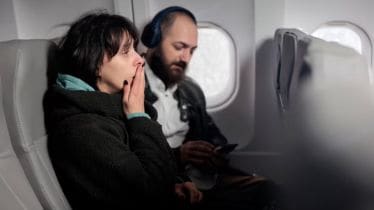From the Air India crash in Ahmedabad to the recent helicopter accident in Kedarnath and reports of technical snags on flights, many people are now afraid to fly. These back-to-back incidents have not only dominated news headlines but also triggered anxiety and fear among many travellers. If you’ve found yourself feeling uneasy about flying, or even avoiding it completely, you’re not alone. Fear of flying, known as aviophobia, is more common than you think. And during times like these, it tends to increase.
So, how do you deal with that tight feeling in your chest when boarding a flight? Or the racing thoughts every time the plane shakes a little due to turbulence? We spoke to Dr. Shaunak Ajinkya, a leading psychiatrist at Kokilaben Dhirubhai Ambani Hospital, who shares practical tips, therapies, and strategies that can help you fly with more confidence and calm.
“Fear after a crash is normal,” says the expert
“After hearing about aviation incidents, it’s natural to feel fear or anxiety. But when that fear starts affecting your daily life or travel plans, it’s worth addressing,” says Dr. Ajinkya.
He explains that some people may develop flight phobia due to a traumatic experience, while others may simply become more anxious over time after consuming repeated news or hearing distressing stories.
How professional help can make you overcome flight anxiety
Dr. Ajinkya recommends professional therapy, especially if the fear is intense or long-standing. The most effective approach is Cognitive Behavioural Therapy (CBT).
“CBT is one of the most successful methods we use,” he shares. “It helps people identify irrational fears, like ‘the plane will crash,’ and replace them with logical facts, such as how rare and safe air travel actually is.”
CBT also includes practical tools like:
- Deep breathing exercises
- Progressive muscle relaxation
- Grounding techniques
Exposure therapy
Another effective method is exposure therapy, which involves slowly getting used to the idea of flying in stages. You may start by watching videos of airplanes, visiting an airport, sitting inside a parked plane, and eventually, taking a short flight.
Virtual Reality Exposure Therapy (VRET)
For tech-savvy patients, Virtual Reality Exposure Therapy (VRET) is also available. It allows patients to experience flight simulations—complete with takeoffs, turbulence, and landings—while practising relaxation techniques.
Eye movement desensitisation and reprocessing: For trauma-related fear
If someone has been through a traumatic event, EMDR (Eye Movement Desensitization and Reprocessing) therapy can help process the emotional pain linked to flying.
“EMDR is particularly helpful for people who have witnessed or survived accidents,” Dr. Ajinkya explains. “It helps reduce the emotional intensity of those memories.”
Other useful approaches include:
- ACT (Acceptance and Commitment Therapy) – Helps you accept the fear but still do what’s meaningful (like taking a flight).
- Hypnotherapy – Explores deeper reasons for the phobia and may provide relief through guided sessions.
Easy coping strategies to try on your own
You don’t always need to be in therapy to take the first steps. Here are some simple tips that can help:
– Practise breathing techniques
Try the 4-7-8 method: inhale for 4 seconds, hold your breath for 7 seconds, and exhale slowly for 8 seconds. Repeat a few times. This calms the nervous system.
– Use grounding techniques
One method is the 5-4-3-2-1 technique: Name 5 things you can see, 4 you can touch, 3 you can hear, 2 you can smell, and 1 you can taste. This pulls you back into the present moment.
– Distract yourself
Download a good movie, create a calming playlist, or bring a puzzle or book onboard. Distraction can keep anxiety from spiralling.
– Pick the right seat
“Seats over the wings often experience less turbulence,” says Dr. Ajinkya. “Aisle seats can give you more space and the freedom to move around.”
– Talk to flight staff
Let the crew know you’re feeling nervous. “Cabin crew are trained to assist anxious flyers and can check on you during the flight,” he adds.
What to avoid before flying
- Skip caffeine and alcohol before boarding—they can worsen anxiety.
- Don’t doomscroll. Avoid watching or reading too many crash reports before your trip.
- Don’t bottle up your feelings. Talking to friends, family, or a support group helps lighten the emotional load.
Can medication help?
Yes, but only when needed, and always under professional guidance.
“For some, anti-anxiety medication may be recommended—especially if there’s severe anxiety, panic attacks, or PTSD involved. But this works best when combined with therapy,” says Dr. Ajinkya.
‘Fear of flying’ courses are also an option
Some airlines and private programs offer special workshops for nervous flyers. These include:
- Talks by pilots explaining how planes work
- Tips from mental health professionals
- Simulated flights
- A supervised short flight at the end of the program
“These courses are a great hands-on way to build confidence,” Dr. Ajinkya recommends.
Fear doesn’t have to hold you back
It’s okay to feel afraid, especially after traumatic news. But fear doesn’t have to keep you grounded.
“With support and the right steps, most people can learn to manage or overcome their fear of flying,” Dr. Ajinkya reassures.
So the next time you’re boarding a flight, remember: you’ve got strategies, and experts ready to help. You can choose calm over panic—and maybe even enjoy the view from 35,000 feet.
